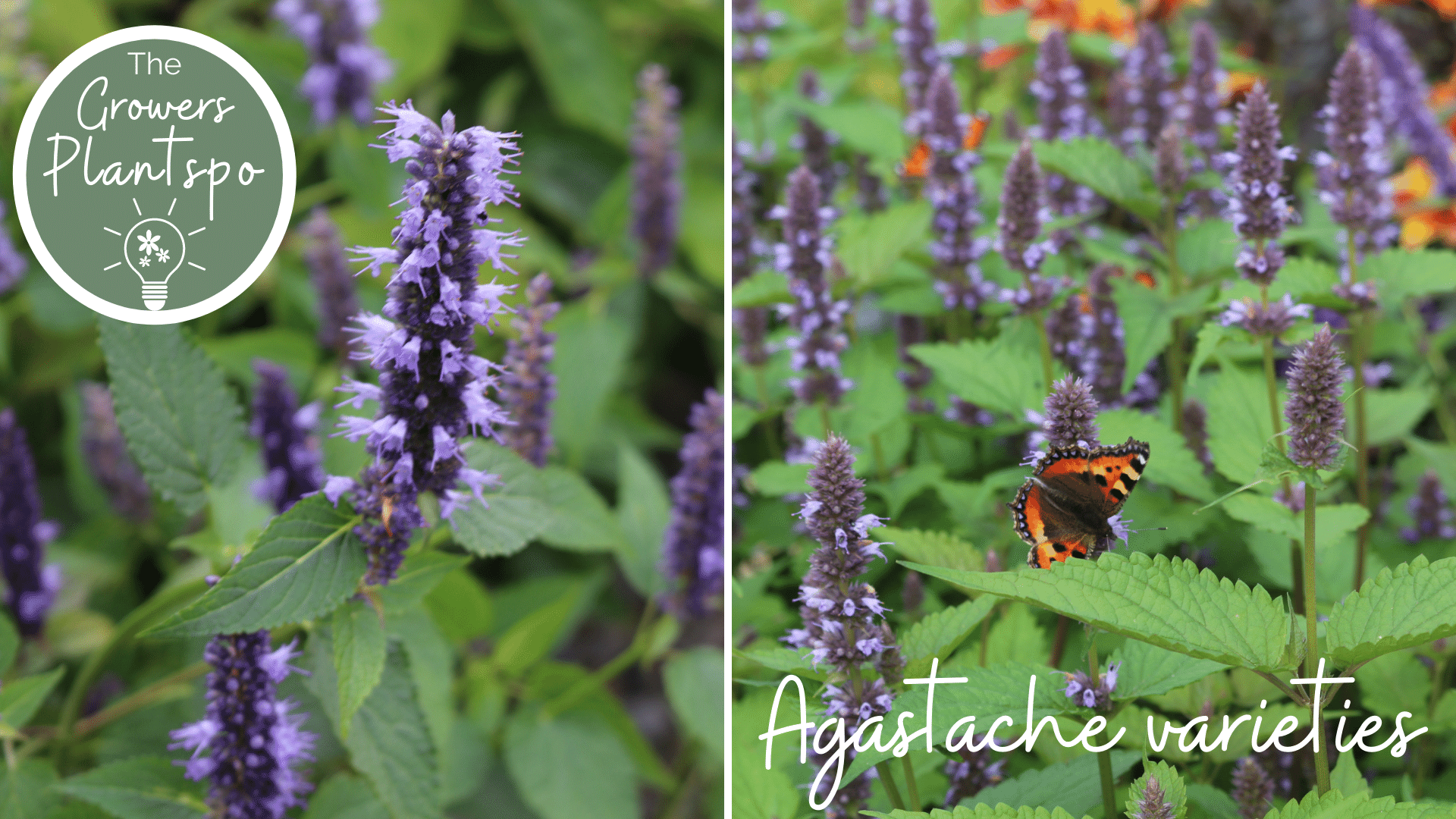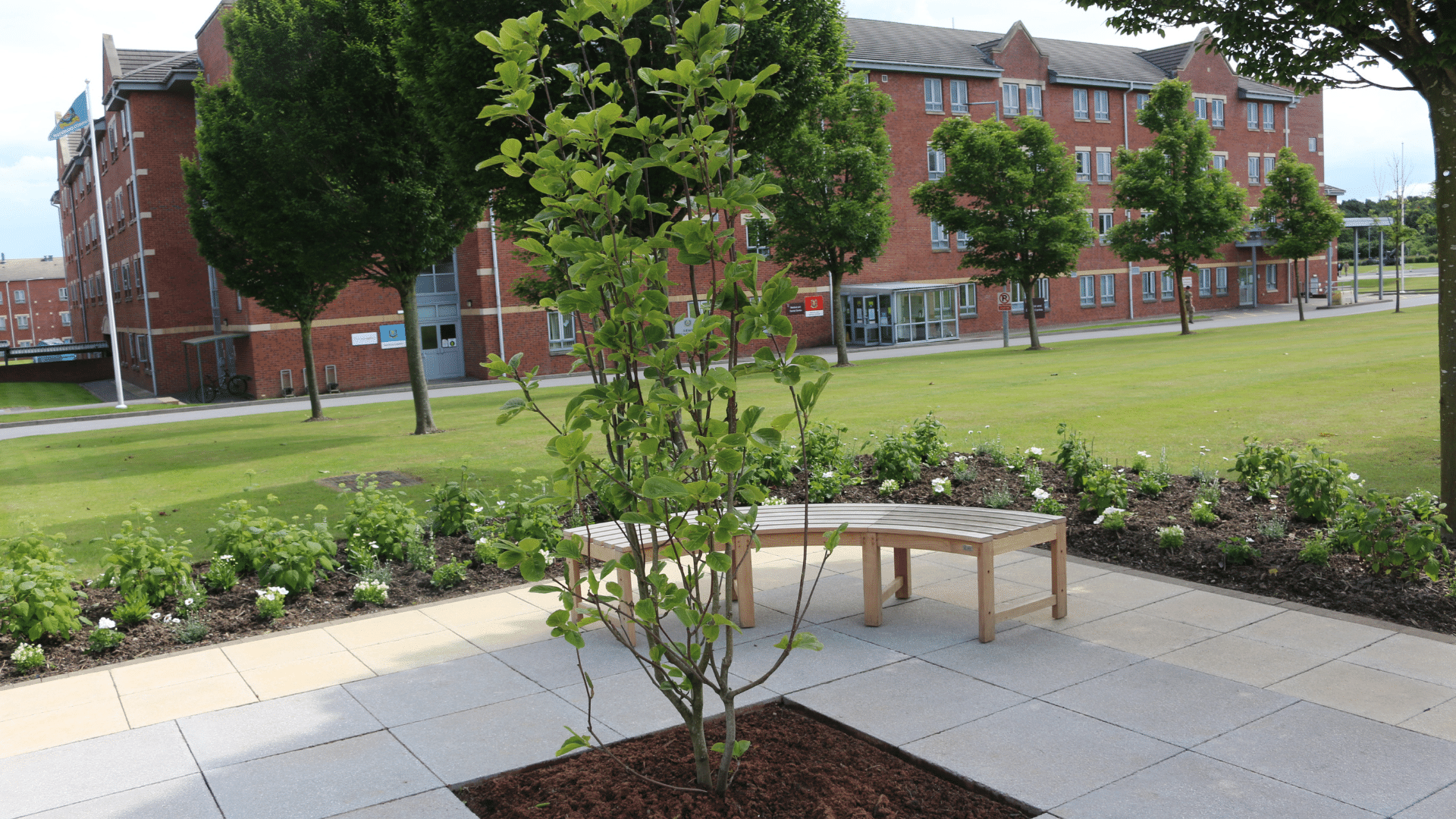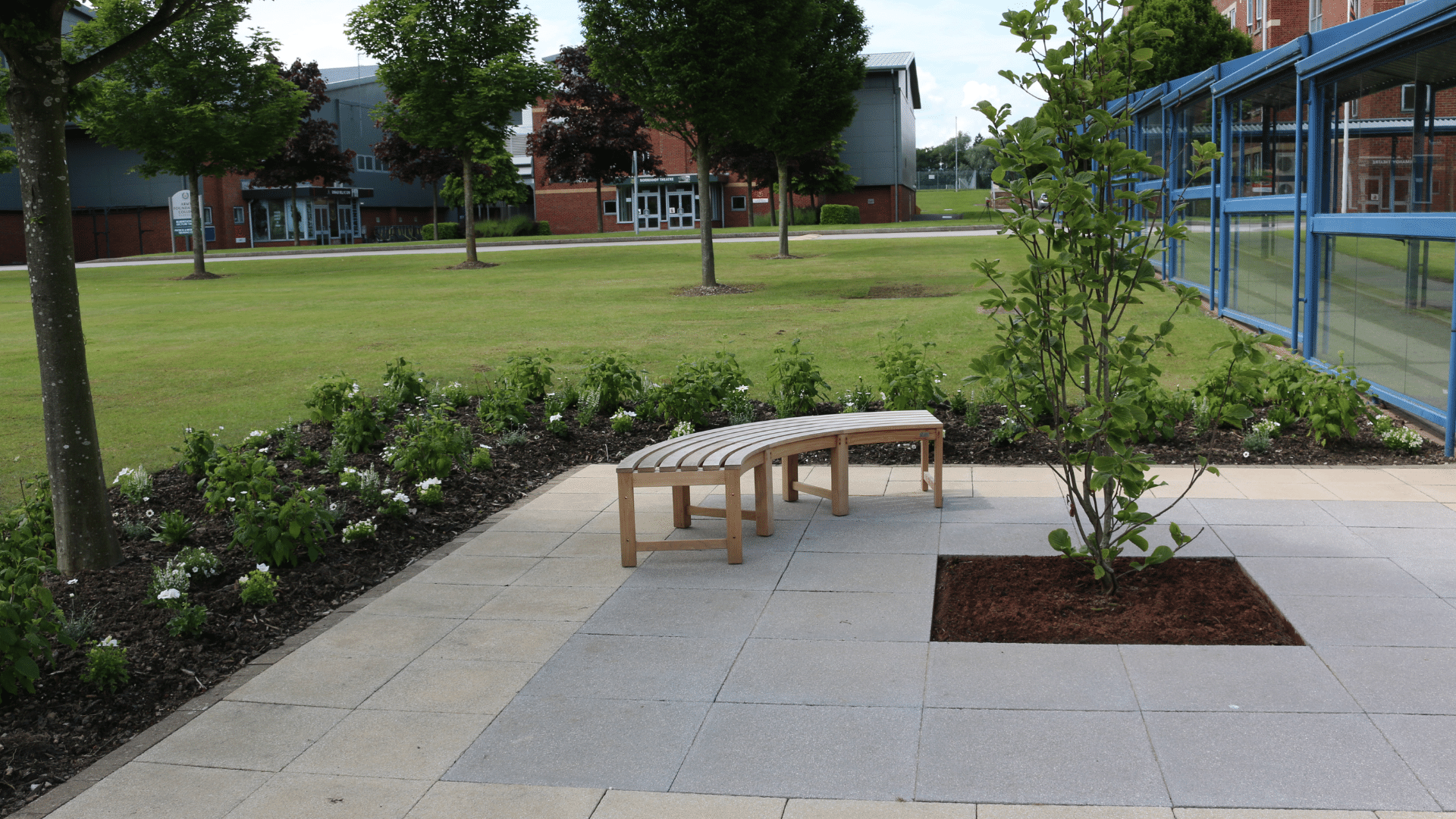
Looking for late-summer inspiration for your next garden project? We’ve rounded up a beautiful selection of late-flowering herbaceous perennials that bring colour, texture, and pollinator appeal from August through autumn.
Each plant below includes flowering season, preferred position, height, soil type, and pot sizes available – so you can pick the right one for your space.

Achilleas are a great addition to a mixed border or cottage garden in full sun – partial shade with flat-topped flowers that bloom from June – September with many cultivars and colours to choose from ranging from yellow to white and pink.


Height: Up to 1m (depending on variety)
![]() Soil: Moist, well-drained soil
Soil: Moist, well-drained soil
![]() Pot size: 2L, 3L, 5L (depending on variety and subject to availability)
Pot size: 2L, 3L, 5L (depending on variety and subject to availability)
———————————————————————————————

Anemone (Japanese Windflower) is a graceful perennial that blooms from late summer into autumn, adding soft colour and movement to borders. With tall, airy stems and delicate pink or white flowers, it’s ideal for partial shade and pairs beautifully with ferns and grasses. Low-maintenance and long-flowering, it’s a standout in late-season gardens.


Height: Up to 1.2m (depending on variety)
![]() Soil: Moist, fertile, humus-rich soil
Soil: Moist, fertile, humus-rich soil
![]() Pot size: 2L, 3L (depending on variety and subject to availability)
Pot size: 2L, 3L (depending on variety and subject to availability)
———————————————————————————————
Alchemilla mollis (Lady’s Mantle) is a hardy perennial known for its soft, scalloped leaves that catch dewdrops and airy sprays of yellow-green flowers in early summer. It thrives in sun or partial shade, spreads gently, and makes an excellent groundcover or edging plant. Perfect for softening paths and mixing with cottage garden perennials.



Height: Up to 0.6m
![]() Soil: Humus-rich soil
Soil: Humus-rich soil
![]() Pot size: 2L, 3L, 5L
Pot size: 2L, 3L, 5L
———————————————————————————————
Alstroemeria (Peruvian Lily) is a long-flowering perennial prized for its vibrant, lily-like blooms that appear from late spring through autumn. Available in a wide range of colours—pink, orange, red, yellow, and white—its flowers are perfect for cutting and last well in vases. Alstroemeria thrives in sun or partial shade, prefers well-drained soil, and offers a bold splash of colour in borders or containers.



Height: Up to 0.9m (depending on the variety)
![]() Soil: Fertile, moist, well-drained soil
Soil: Fertile, moist, well-drained soil
![]() Pot size: 3L
Pot size: 3L
——————————————————————————————–
Agastache (also known as Hyssop or Hummingbird Mint) is a fragrant, upright perennial prized for its spikes of tubular flowers in shades of purple, pink, orange, or blue from mid-summer to autumn. Loved by bees, butterflies, and hummingbirds, it thrives in full sun and well-drained soil, tolerating heat and drought. Its aromatic foliage and long bloom time make it perfect for pollinator gardens, prairie-style borders, and dry, sunny spots.



Height: Up to 1m (depending on the variety)
![]() Soil: Fertile, well-drained soil
Soil: Fertile, well-drained soil
![]() Pot size: 2L. 3L
Pot size: 2L. 3L
——————————————————————————————–
Agapanthus (African Lily) is a striking perennial known for its tall stems topped with globe-like clusters of blue, violet, or white flowers in mid to late summer. Its strappy green leaves form neat clumps, and it thrives in sunny, well-drained spots, making it ideal for borders or containers. Drought-tolerant and elegant, Agapanthus adds bold, architectural interest to the garden.



Height: Up to 1m (depending on variety)
![]() Soil: Fertile, moist, well-drained soil
Soil: Fertile, moist, well-drained soil
![]() Pot size: 2L, 3L, 5L (depending on variety and subject to availability)
Pot size: 2L, 3L, 5L (depending on variety and subject to availability)
——————————————————————————————–
Astrantia (Masterwort) is a charming, long-flowering perennial prized for its delicate, pincushion-like flowers surrounded by papery bracts, blooming from early to late summer. Available in shades of white, pink, and burgundy, it thrives in partial shade and moist, rich soil. Ideal for woodland borders, cottage gardens, and cutting, Astrantia adds a soft, romantic touch and attracts pollinators.



Height: Up to 1m (depending on variety)
![]() Soil: Fertile, moist, preferably humus-rich soil
Soil: Fertile, moist, preferably humus-rich soil
![]() Pot size: 3L
Pot size: 3L
———————————————————————————————
Aster (also known as Michaelmas Daisy) is a late-blooming perennial that brings a burst of colour from late summer into autumn. With daisy-like flowers in shades of purple, pink, blue, or white, it’s a favorite for pollinators, especially bees and butterflies. Asters thrive in full sun to partial shade and work beautifully in borders, wildlife gardens, and mixed plantings.



Height: Up to 0.9m (depending on variety)
![]() Soil: Well-drained, moderately fertile soil
Soil: Well-drained, moderately fertile soil
![]() Pot size: 2L, 3L
Pot size: 2L, 3L
———————————————————————————————
Campanula (Bellflower) is a versatile perennial known for its bell-shaped flowers in shades of blue, purple, or white, blooming from late spring through summer. With varieties ranging from low-growing groundcovers to upright border plants, Campanula thrives in sun or partial shade and prefers well-drained soil. It adds a soft, cottage-garden feel and is great for edging, rock gardens, or mixed borders.



Height: Up to 0.3m (depending on variety)
![]() Soil: Moist, well-drained, soil
Soil: Moist, well-drained, soil
![]() Pot size: 2L
Pot size: 2L
———————————————————————————————
Coreopsis (Tickseed) is a cheerful, long-blooming perennial known for its bright, daisy-like flowers in shades of yellow, gold, orange, or pink. Blooming from early summer to autumn, it thrives in full sun and well-drained soil, and is loved by pollinators. Coreopsis is drought-tolerant, easy to grow, and perfect for borders, wildlife gardens, and sunny containers.



Height: Up to 0.5m (depending on variety)
![]() Soil: Fertile, well-drained soil
Soil: Fertile, well-drained soil
![]() Pot size: 3L
Pot size: 3L
———————————————————————————————
Crocosmia (also known as Montbretia) is a vibrant, clump-forming perennial that produces arching stems of fiery, funnel-shaped flowers in shades of red, orange, or yellow from mid to late summer. Its sword-like foliage adds structure and movement, and the blooms are magnets for bees, butterflies, and hummingbirds. Thriving in full sun to partial shade and well-drained soil, Crocosmia is perfect for adding bold colour to borders and late-summer displays.



Height: Up to 1.2m (depending on variety)
![]() Soil:Moderately fertile, humus-rich, well-drained soil
Soil:Moderately fertile, humus-rich, well-drained soil
![]() Pot size: 3L, 5L
Pot size: 3L, 5L
———————————————————————————————
Dahlia is a show-stopping perennial grown for its striking, colourful blooms that range from small, delicate singles to large, dinner-plate-sized flowers. Blooming from mid-summer until the first frost, dahlias come in nearly every colour except true blue. They thrive in full sun and rich, well-drained soil, and are perfect for cut flower gardens, borders, and statement containers. Though technically tender perennials, dahlias are often lifted and stored over winter in colder climates.



Height: Up to 0.5m (depending on variety)
![]() Soil: Fertile, well-drained soil
Soil: Fertile, well-drained soil
![]() Pot size: 3L
Pot size: 3L
———————————————————————————————
Echinacea (Coneflower) is a bold, upright perennial known for its large, daisy-like flowers with prominent central cones, blooming from mid-summer into autumn. Most commonly found in shades of purple, pink, white, and orange, Echinacea is a magnet for bees, butterflies, and birds. It thrives in full sun and well-drained soil, is drought-tolerant, and adds long-lasting color and structure to prairie-style plantings, wildlife gardens, and sunny borders.



Height: Up to 1m (depending on variety)
![]() Soil: Most soils, except very dry or boggy
Soil: Most soils, except very dry or boggy
![]() Pot size: 2L, 3L
Pot size: 2L, 3L
———————————————————————————————
Erigeron (commonly known as Fleabane) is a charming, low-growing perennial that produces masses of small, daisy-like flowers in shades of white, pink, or lilac with yellow centers. Blooming from late spring through autumn, it thrives in full sun to partial shade and prefers well-drained soil. Erigeron is perfect for cottage gardens, walls, gravel paths, and edging, where it self-seeds gently to form natural-looking drifts.



Height: Up to 0.5m (depending on variety)
![]() Soil: Fertile, well-drained soil
Soil: Fertile, well-drained soil
![]() Pot size: 2L
Pot size: 2L
———————————————————————————————
Eryngium (commonly known as Sea Holly) is a striking perennial known for its spiky, thistle-like flowers in shades of blue, silver, or steel-grey, blooming in mid to late summer. Its bold texture and metallic sheen make it a standout in sunny borders, gravel gardens, or coastal plantings. Eryngium thrives in full sun and well-drained, dry soil, is drought-tolerant, and highly attractive to pollinators—especially bees.



Height: Up to 0.5m (depending on variety)
![]() Soil: dry, well-drained, poor to moderately fertile soil
Soil: dry, well-drained, poor to moderately fertile soil
![]() Pot size: 2L
Pot size: 2L
———————————————————————————————
Geranium (Hardy Geranium or Cranesbill) is a reliable, low-maintenance perennial valued for its mounded foliage and long-lasting, saucer-shaped flowers in shades of pink, blue, purple, or white. Blooming from late spring through summer—and some varieties into autumn—it thrives in sun or partial shade and well-drained soil. Geraniums are excellent for groundcover, edging, or weaving through borders, and many varieties are deer-resistant and pollinator-friendly.



Height: Up to 0.6m (depending on variety)
![]() Soil: Fertile, well-drained soil
Soil: Fertile, well-drained soil
![]() Pot size: 2L
Pot size: 2L
———————————————————————————————
Geum is a cheerful, clump-forming perennial known for its bright, nodding or upright flowers in shades of orange, red, yellow, or peach, blooming from late spring into summer, with some varieties flowering again later in the season. It thrives in full sun to partial shade and prefers moist, well-drained soil. With its compact habit and long flowering period, Geum is perfect for cottage gardens, mixed borders, and pollinator-friendly plantings.



Height: Up to 0.6m (depending on variety)
![]() Soil: Fertile, moist, well-drained soil
Soil: Fertile, moist, well-drained soil
![]() Pot size: 3L
Pot size: 3L
———————————————————————————————
Helenium (commonly known as Sneezeweed) is a vibrant, late-summer perennial that produces daisy-like flowers in rich shades of yellow, orange, red, and bronze, blooming from mid to late summer into early autumn. Its sturdy stems and long bloom time make it ideal for adding bold color to sunny borders and prairie-style plantings. Helenium thrives in full sun and moist, well-drained soil, and is a magnet for pollinators. Despite the name, it doesn’t cause sneezing!



Height: Up to 1m (depending on variety)
![]() Soil: Fertile, moist, well-drained soil
Soil: Fertile, moist, well-drained soil
![]() Pot size: 2L
Pot size: 2L
———————————————————————————————
Leucanthemum (commonly known as the Shasta Daisy) is a classic, long-flowering perennial loved for its bold, white, daisy-like flowers with yellow centers, blooming from early summer into autumn. It thrives in full sun and well-drained soil, adding a fresh, cheerful look to borders, cottage gardens, and pollinator-friendly plantings. Compact, upright, and easy to grow, Leucanthemum pairs beautifully with grasses and late-summer perennials.



Height: Up to 1m (depending on variety)
![]() Soil: Moderately fertile, moist but well-drained soil
Soil: Moderately fertile, moist but well-drained soil
![]() Pot size: 2L, 3L
Pot size: 2L, 3L
———————————————————————————————
Liatris (commonly known as Blazing Star or Gayfeather) is a striking, upright perennial valued for its tall spikes of fluffy, purple or white flowers that bloom top to bottom from mid to late summer. Its grassy, clump-forming foliage stays neat, and the blooms are highly attractive to bees, butterflies, and other pollinators. Liatris thrives in full sun and well-drained soil, making it perfect for prairie-style borders, wildlife gardens, and sunny beds. It’s also drought-tolerant and excellent for cut flowers.



Height: Up to 1m (depending on variety)
![]() Soil: Moderately-fertile, reliably moist soil
Soil: Moderately-fertile, reliably moist soil
![]() Pot size: 2L, 3L
Pot size: 2L, 3L
———————————————————————————————
Monarda (commonly known as Bee Balm) is a vibrant, aromatic perennial loved for its tufted, shaggy flowers in shades of red, pink, purple, and white, blooming from mid to late summer. Highly attractive to bees, butterflies, and hummingbirds, it’s a must-have for pollinator-friendly gardens. Monarda thrives in full sun to partial shade and prefers moist, well-drained soil. Its mint-scented foliage adds extra appeal, and newer mildew-resistant varieties are great for border plantings.



Height: Up to 0.4m (depending on variety)
![]() Soil: Fertile, moist, well-drained soil
Soil: Fertile, moist, well-drained soil
![]() Pot size: 2l, 3L (depending on variety and subject to availability).
Pot size: 2l, 3L (depending on variety and subject to availability).
———————————————————————————————
Nepeta (commonly known as Catmint) is a hardy, aromatic perennial known for its soft, grey-green foliage and clouds of small, lavender-blue flowers that bloom from late spring through summer, often into autumn. It thrives in full sun and well-drained soil, is drought-tolerant, and attracts bees and pollinators. With its relaxed, billowy habit, Nepeta is perfect for softening path edges, filling gaps in borders, or pairing with roses and grasses.



Height: Up to 0.9m (depending on variety)
![]() Soil: Moist, well-drained soil
Soil: Moist, well-drained soil
![]() Pot size: 2l, 3L, 5L (depending on variety and subject to availability).
Pot size: 2l, 3L, 5L (depending on variety and subject to availability).
———————————————————————————————
Penstemon (commonly known as Beardtongue) is a long-flowering perennial admired for its tall spires of tubular flowers in shades of pink, purple, red, white, or blue, blooming from early summer into autumn. Its elegant, upright form and nectar-rich blooms make it a favourite with bees and hummingbirds. Penstemon prefers full sun and well-drained soil, and works beautifully in mixed borders, cottage gardens, and pollinator-friendly plantings. Deadheading encourages a longer bloom period.



Height: Up to 1m (depending on variety)
![]() Soil: Fertile, moist, well-drained soil
Soil: Fertile, moist, well-drained soil
![]() Pot size: 2l, 3L (depending on variety and subject to availability).
Pot size: 2l, 3L (depending on variety and subject to availability).
———————————————————————————————
Persicaria (commonly known as Knotweed or Bistort) is a bold, long-flowering perennial known for its dense spikes of small flowers in shades of red, pink, or white, blooming from mid-summer into autumn. It thrives in sun or partial shade and prefers moist, well-drained soil, making it ideal for naturalistic borders, damp spots, or prairie-style plantings. With its spreading habit and extended bloom time, Persicaria adds texture, movement, and late-season colour to the garden—and is loved by pollinators too



Height: Up to 1m (depending on variety)
![]() Soil: Any moist soil
Soil: Any moist soil
![]() Pot size: 2l (depending on variety and subject to availability)
Pot size: 2l (depending on variety and subject to availability)
———————————————————————————————
Perovskia (commonly known as Russian Sage) is a striking, aromatic perennial valued for its silvery-grey foliage and airy spikes of lavender-blue flowers, blooming from mid-summer into autumn. It thrives in full sun and well-drained soil, and is both drought-tolerant and deer-resistant. Perovskia adds a soft, hazy texture to borders and pairs beautifully with grasses, echinacea, and rudbeckia in prairie-style or Mediterranean plantings. It’s also a magnet for bees and butterflies.



Height: Up to 1.2m (depending on variety)
![]() Soil:Well-drained, poor to moderately fertile
Soil:Well-drained, poor to moderately fertile
![]() Pot size: 2l, 5L (depending on variety and subject to availability)
Pot size: 2l, 5L (depending on variety and subject to availability)
———————————————————————————————

Rudbeckia (commonly known as Black-eyed Susan) is a bold, late-summer perennial known for its bright yellow or gold daisy-like flowers with distinctive dark central cones. Blooming from mid-summer into autumn, it thrives in full sun and well-drained soil, and is loved by bees, butterflies, and birds. Rudbeckia adds vibrant colour and structure to borders, prairie-style plantings, and pollinator gardens, and pairs well with grasses and other late-season perennials.


Height: Up to 0.8m (depending on variety)
![]() Soil: Moderately fertile, preferably heavy but well-drained soil
Soil: Moderately fertile, preferably heavy but well-drained soil
![]() Pot size: 2l, 3L (depending on variety and subject to availability)
Pot size: 2l, 3L (depending on variety and subject to availability)
———————————————————————————————
Salvia (commonly known as Sage) is a vibrant, long-flowering perennial known for its spikes of tubular flowers in shades of blue, purple, pink, or red, blooming from late spring through summer, often into autumn. It thrives in full sun and well-drained soil, is drought-tolerant, and highly attractive to bees, butterflies, and hummingbirds. With aromatic foliage and a tidy habit, Salvia is perfect for borders, pollinator gardens, and Mediterranean-style plantings.



Height: Up to 1.2m (depending on variety)
![]() Soil: Moderately fertile, moist but well-drained soil
Soil: Moderately fertile, moist but well-drained soil
![]() Pot size: 2l, 3L,5L (depending on variety and subject to availability)
Pot size: 2l, 3L,5L (depending on variety and subject to availability)
———————————————————————————————
Sanguisorba (commonly known as Burnet) is a graceful, clump-forming perennial valued for its tall, slender stems topped with bottlebrush-like flower heads in shades of crimson, pink, or white, blooming from mid to late summer into autumn. It thrives in full sun to partial shade and prefers moist, well-drained soil. With its airy form and soft movement, Sanguisorba is ideal for naturalistic, prairie-style, or cottage garden plantings, and is a favourite of pollinators.



Height: Up to 0.6m (depending on variety)
![]() Soil: Poor-to-average, moist, well-drained soil
Soil: Poor-to-average, moist, well-drained soil
![]() Pot size: 2l, 3L (depending on variety and subject to availability)
Pot size: 2l, 3L (depending on variety and subject to availability)
———————————————————————————————
Scabiosa (commonly known as Pincushion Flower) is a charming perennial known for its dainty, pincushion-like blooms in shades of blue, lavender, pink, or white, flowering from late spring through to autumn. Loved by bees and butterflies, it thrives in full sun and well-drained soil, and makes an excellent addition to cottage gardens, borders, and pollinator-friendly plantings. Its compact habit and long bloom time also make it ideal for containers and cut flower gardens.



Height: Up to 0.5m (depending on variety)
![]() Soil: Moderately fertile, well-drained, neutral to slightly alkaline soil
Soil: Moderately fertile, well-drained, neutral to slightly alkaline soil
![]() Pot size: 2l, 3L (depending on variety and subject to availability)
Pot size: 2l, 3L (depending on variety and subject to availability)
———————————————————————————————
Sedum (commonly known as Stonecrop) is a hardy, drought-tolerant perennial prized for its fleshy, succulent leaves and flat-topped flower heads that bloom from late summer into autumn. Flowers come in shades of pink, red, or white, and are highly attractive to bees and butterflies. Sedum thrives in full sun and well-drained soil, making it ideal for borders, gravel gardens, and containers. Its upright varieties add structure and seasonal colour, while low-growing types work well as groundcover.



Height: Up to 0.6m (depending on variety)
![]() Soil: Moderately fertile, well-drained, neutral to slightly alkaline soil
Soil: Moderately fertile, well-drained, neutral to slightly alkaline soil
![]() Pot size: 2l, 3L, 5L (depending on variety and subject to availability)
Pot size: 2l, 3L, 5L (depending on variety and subject to availability)
———————————————————————————————
Verbena (especially Verbena bonariensis) is a tall, airy perennial known for its clusters of small, purple flowers held on slender, upright stems that bloom from summer into autumn. It thrives in full sun and well-drained soil, and is a magnet for bees, butterflies, and other pollinators. With its see-through form, Verbena adds height without blocking views, making it ideal for naturalistic borders, wildlife gardens, and contemporary plantings. It often self-seeds and returns reliably year after year.



Height: Up to 2m (depending on variety)
![]() Soil: Moderately fertile, moist but well-drained soil
Soil: Moderately fertile, moist but well-drained soil
![]() Pot size: 2L, 3L (depending on variety and subject to availability)
Pot size: 2L, 3L (depending on variety and subject to availability)
———————————————————————————————
Veronica (commonly known as Speedwell) is a versatile perennial admired for its dense spikes of small, tubular flowers in shades of blue, purple, pink, or white, blooming from early summer to late summer. With a tidy, upright habit, it thrives in full sun and well-drained soil, attracting bees, butterflies, and other pollinators. Veronica is perfect for mixed borders, cottage gardens, and pollinator-friendly spaces, and deadheading encourages a longer bloom period.



Height: Up to 1m (depending on variety)
![]() Soil: Moderately fertile, moist but well-drained soil
Soil: Moderately fertile, moist but well-drained soil
![]() Pot size: 2L, 3L (depending on variety and subject to availability)
Pot size: 2L, 3L (depending on variety and subject to availability)
———————————————————————————————
Looking for even more late-season colour?
👉 Check out our companion guide: The Grower’s Choice – Late Summer Blooms
Posted 29th Jul 2:10pm
Read more >

We have recently donated plants worth hundreds of pounds to two Yorkshire NHS hospitals.
The newly created Rainbow Garden at Doncaster Royal Infirmary has benefited from a donation of plants worth £500. The garden, which is situated near the main entrance of the hospital, was designed to create a place where visitors and staff could go to remember the town’s 900 plus Covid-19 victims.

Colleagues at the hospital had been raising funds since June 2020 for the project, with almost 300 supporters providing donations both large and small.
The memorial garden features flower beds, a central lawn, paving, a patio and a pergola, all of which our Doncaster-based customer, AWS Landscapes Ltd kindly provided at cost.
Plants supplied and donated include Lavandula ‘Victory’, Prunus laur. ‘Rotundifolia’, Hydrangea pan. ‘Little Lime’, Cotinus ‘Royal Purple’, Magnolia soulangeana, Achillea ‘Walther Funcke’, Echinacea purpurea, Heuchera ‘Palace Purple’ and Persicaria affinis ‘Superba’.
A similar garden has been created at the hospital’s sister facility at Bassetlaw.

Harrogate Hospital and Community Charity have also received plants from Johnsons worth more than £300. The plants were first used at the Harrogate Flower Show earlier this year as part of a gold award-winning display created by Lisa Norton from Harrogate Garden Design.
The display, entitled Escape Your Mind, featured an array of plants such as Buxus Sempervirens, Euphorbia, Pittosporum Magnolia Acuminata ‘Blue Opal’, Dahlia ‘Orange Sunshine, Phlox ‘Clouds of Perfume’, Cortaderia ‘Pink Feather’ and Salix ‘Golden Sunshine’. These have now been replanted at the hospital for staff and visitors to enjoy, providing an area of rest and reflection.
Richard Parker OBE, chief executive at Doncaster and Bassetlaw Teaching Hospitals, said: “On behalf of all within Team DBTH, I want to thank Johnsons of Whixley and AWS Landscapes Ltd for their contributions to our Rainbow Gardens. The generosity shown towards our Trust throughout the past 18 months or so has been nothing short of spectacular and I am so pleased that, together, we have been able to create these beautiful memorial spaces for those who are sadly no longer with us. Once again, thank you.”

Harrogate Hospital’s business development charity and volunteer manager Sammy Lambert commented: “On behalf of the Trust I would like to thank Johnsons and Harrogate Garden Design for their generosity and donation of beautiful plants which have made such a difference to our outside areas.”
David Sowerby, director of AWS Landscapes Ltd, said: “We are indebted to all the NHS staff who have given so much during the pandemic, and to those who sadly lost their lives. As a mark of our thanks and respect, we made our own donation and carried out all the works to create this garden for all to enjoy. We hope that the garden can be a beautiful space where staff and visitors can rest and reflect away from the stress of their busy working day.”
We are incredibly pleased to be able to give something back to both hospitals via our donation of plants which has helped two outside areas bloom. We are forever grateful to the NHS staff who have given so much over the past 18 months and that they continue to do so. We hope our plants are enjoyed by staff and visitors for many years to come.
This is one of many plant donations this year, as we pledged to donate plants to 12 different charities throughout our Centenary these donations have included plants to The Blue Cross, Thirsk, a memorial garden for Sir Captain Tom Moore and Henshaw’s Arts and Crafts.
Posted 27th Jul 4:37pm
Read more >

We recently teamed up with a landscaping firm and our customer Ray Skelton (Harrogate) Ltd to help create a touching memorial for a national hero and campaigner, Capt Sir Tom Moore.
This year we celebrate our Centenary while the late Capt Sir Tom, who raised millions of pounds for the NHS, celebrated his 100th birthday in April 2020. He passed away in February this year.

The memorial was unveiled on the 7th July in front of World War II veteran Capt Sir Tom’s family, Junior Soldiers and sponsors such as Ray Skelton (Harrogate) Ltd and Johnsons.

Chairman John Richardson and his grandaughter and Marketing Manager Eleanor Richardson attended with Director Stuart Skelton of Ray Skelton (Harrogate) Ltd and Colin Simpson.
Ray Skelton (Harrogate) Ltd commissioned Kris Elvidge, a local Stone Mason, himself a Yorkshireman, to engrave the stones that can be seen on the front and back of the college headquarters identifying the start and finish of the Capt Sir Tom Moore Walk. They also created 4 seating areas that surround a centre stone halfway along the main walkway taken by junior soldiers on parade day.

Through landscaper Ray Skelton (Harrogate) Ltd, Johnsons donated two Magnolia ‘Double Diamond’ 200-250 110L trees and 50 Hydrangea arborescens ‘Annabelle’ worth a total of £765 to the memorial at Army Foundation College Harrogate, where he was an honorary colonel.

The trees are among six planted by Junior Soldiers from the Army college in honour of Capt Sir Tom and to launch the Queen’s Green Canopy campaign across the country.
The Queen’s Green Canopy is a tree planting initiative to mark the Queen’s Platinum Jubilee in 2021. People across the UK are being invited to ‘plant a tree for the jubilee’, with community groups and schools encouraged to take part from October, when the tree planting season begins.

Capt Sir Tom captured the nation’s hearts when he raised over £32m for NHS Charities by walking 100 laps of his garden during the first lockdown. He was born in Keighley but more recently lived in Marston Moretaine in Bedfordshire.

He inspired millions when his saying ‘Tomorrow will be a good day’ trended on social media and became the oldest ever recording artist to reach number one when his duet of You’ll Never Walk Alone with Michael Ball topped the charts. On his 100th birthday, he received thousands of cards from well-wishers across the world, including the Queen and Prime Minister, and was honoured with an RAF flypast.
Eleanor Richardson, Johnsons of Whixley’s marketing manager, said: “We were delighted to be part of this fitting tribute to Capt Sir Tom Moore, who was a true inspiration. The donation is particularly fitting as the magnolia is native to Asia, where he served during World War II.”
Stuart Skelton, Director of Ray Skelton (Harrogate) Ltd said “It has been an honour and a privilege to be involved in the Capt Sir Tom Moore Memorial, hopefully, this will continue to inspire future generations of Junior Soldiers”
Posted 15th Jul 11:34am
Read more >

Not sure what to do in the garden this month? check out our July gardening reminders put together by Chairman and Horticulturist John Richardson.
1) Keep control of soft, fast-growing weeds such as thistles, they harbour aphids and other problems.
2) Now is the time to make yourself a good big compost bin, just before you really need it! Ideally, use 4 stakes as corners 1 metre apart in a square and staple wire netting (1 metre deep) around the square.
This affords easy entry when you wish to empty it, or it can be made bigger or smaller at will. If you would like a really permanent one, use pressure-treated plywood or boards instead of netting.
3) Treat shrubs that were cut back in the spring with a high Sulphate of Potash feed to encourage the production of flower buds for next year.

4)Prune shrubs grown on walls and pergolas to remove some of the top growth and further stimulate growth from the base of the plant.
5) Evergreen hedges can be clipped this month (and some deciduous ones), but ensure there are no nesting birds in the hedge or bush. Cut laurel and Eleagnus hedges with secateurs to prevent cut leaves.
In hot weather, spray newly planted container-grown hedge plant foliage with water as well as ensuring that the root zone continues to be kept moist.
6) Lift tulip bulbs after they have fully died down and store them in paper bags in a dry and airy place over the summer.
7) Keep hydrangeas well-watered, particularly those growing in containers, as they quickly show signs of drought, and it can be difficult to get them to fully recover.
8) Check the moisture level of hanging baskets every morning, and water thoroughly if dry. Feed plants with a soluble or liquid feed once per week and remove flower-heads that are going over.
9) Divide established clumps of bearded iris immediately after blooming and plant in the ground or in containers and keep moist. Discard the older exhausted rhizomes, and cut back the foliage of the new plants to approximately 12-15cm.
10) Now is the time to sort out your autumn bulb order, to give you maximum choice for next year. Bulb catalogues are now really helpful and a pleasure to look at. Planting early has benefits for almost all bulbs, but leave tulips until late November in order to prevent disease infection.

11) Remove spent rose flower heads and maintain spraying as necessary to combat greenfly, rust, mildew and black spot, as appropriate. Apply a summer rose feed in the middle of the month.
12) Take softwood cuttings of a range of shrubs by selecting healthy young shoots, the cutting s to be 5-8cm long with 2 leaves retained at the top of the cutting. Cut the base cleanly with a knife, just below a node (leaf joint). Dip the base of the cutting in rooting hormone and insert around the edges of a plastic pot in a very gritty compost and cover with clear polythene supported above the foliage. Among many ideal subjects would be Asters, Ceanothus, Cistus, Escallonia, & Hydrangea.
13) Keep a pair of secateurs in your pocket as you wander around the garden, being able to dead-head those flowers which have gone over will ensure a second flush of flowers in many cases.
14) Be sure to keep the bird baths topped up in the hottest of weather!
15) After the natural ‘June drop’ of many fruit trees, thin the remaining fruits to ensure the full development of the best trusses. Where branches are carrying heavy loads of fruit it is well worth considering support for the heaviest, particularly in the case of plums.
16) When Strawberries have finished fruiting trim back the foliage with shears and remove with any straw mulch which had been applied to protect and support the fruit. This waste can be composted.
In need of more hints and tips for your projects? check out our solution page by clicking here
Posted 6th Jul 9:30am
Read more >

We have continued our donation of hundreds of plants to Yorkshire charities as part of our centenary celebration.
We celebrated our 100th birthday this June and are marking our centenary year with a donation of plants to a different charity each month. The latest donation we made was to York Cares Big Community Challenge 2021.
The York Cares Big Community Challenge 2021 took place between the 9-30th June at Rowntree Park, with 17 volunteering sessions engaging more than 200 volunteers.
We worked in partnership with the City of York Council Environment and Communities Team and the Friends of Rowntree Park, to prepare the park for its centenary celebration this July.
York Cares has organised volunteers to clear and weed areas that have been affected by the floods. The volunteers will be replanting and starting the transformation of a part of the park into a new educational wildlife area, thanks to funding from Yorkshire Water.

Our donation of plants to the value of £200 has been used to revitalise the family picnic garden, which will host families and friends over the summer who go to enjoy the park.
The initiative is part of the York Cares Big Community Challenge 2021, where local businesses volunteer the services of their employees to transform a community space over the month of June.

York Cares aims to showcase the positive impact a green environment can have on health, wellbeing, and social inclusion.
Eleanor Richardson, marketing manager at Johnsons, said: “We are pleased to have donated £200 worth of plants for the Big Community Challenge in June, which will make a transformative difference to Rowntree Park.
“Many of us have benefited greatly from spaces like this throughout the pandemic so it is a wonderful opportunity to give something back while helping to celebrate both our own and the park’s centenary.”

Katy Elliott, volunteering support officer at York Cares Big Community Challenge, added: “We are incredibly grateful to Johnson’s of Whixley for their donation of plants which will make a real difference to one of the areas of the park.
Stu Small, Friends of Rowntree Park Gardener said: “Friends of Rowntree Park are pleased that Johnson’s was able to make a generous donation of plants to support our volunteer gardening programme. Like Johnson’s, Rowntree Park is also celebrating its centenary in 2021. The plants from Johnson’s have helped make an instant impact in our family picnic garden.”
Posted 6th Jul 10:01am
Read more >